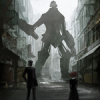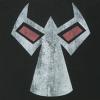General Progress
When I decided to get serious about re-learning to draw in early October, I made a couple of sketches which I figured would provide interesting contrast after some instruction. See
understatement.




To me, the hand from November 19 shows how far I've come in terms of local perception, enabling me to draw with much greater fidelity to the real world subject. I think I am still developing my global perception, which the series of drawings that follow will illustrate.
Life Drawing
I've been taking a life drawing class for three weeks now, and I've seen significant improvement in my work, to the point where I'm experimenting with materials and technique.
My first ten sketches in the life drawing class, over two sessions (the class is once a week) show me struggling with the quick, four-minute poses that we use to warm up, and with composition. I tended to make the short-duration drawings too detailed, focusing on shading various parts of the body and not completing the overall image. I also tended to leave plenty of blank space around my figures. The images speak for themselves:










I decided to try charcoal for the quick sketches, and it let me draw fuller, less detailed poses much more quickly. I'm still mastering it (plus I'm using a simple charcoal stick, not a charcoal pencil), but I've pretty much decided on it for the four-minute poses, switching to pencil starting at 10-minute duration.




The next challenge was fixing my composition, as my figures tended to "shrink" from my original estimation as I added details and refined lines.. The instructor showed me a technique of visualizing the primitive shapes that enclose the model and prop - typically some variant on the triangle or rhombus - and encouraged me to size the enclosing primitive first, then use it as a guide when drawing my figure.


The following are the sketches from Monday, November 20, 2006. There's one pretty bad misfire in there, but otherwise they're pretty decent. I'm particularly proud of the last image, which represents my first step into a new approach to light and shade: rather than hatching alone, as I have done so far (ignoring tragic experiments with using charcoal to shade pencil drawings), I fill the entire area with a mid-tone and then darken strong shadows and use a kneaded eraser to create areas of highlight.












As you can see, in many places I have subtle problems of proportion. I find that this is a result of my "narrowing in" on the part of the body that I am drawing and failing to see the whole. Some of yesterday's drawings did point that out to me such that I became quite conscious of it, and I expect that next week's drawings will be much better. I will probably look for key points in the pose, such as checking the relationship of the feet in img30
early in the drawing.
In any case, I'm posting this for comment and crit, as usual. I'm also linking to it from my participation thread in the
Freehand Drawing Workshop forum as encouragement to other participants to
just continue drawing. I've found near-daily practice (with a growing awareness of errors both in my finished product and in my cognitive/creative process) to have been the most important factor in my improvement.
Bombs away! [smile]



 To me, the hand from November 19 shows how far I've come in terms of local perception, enabling me to draw with much greater fidelity to the real world subject. I think I am still developing my global perception, which the series of drawings that follow will illustrate.
Life Drawing
I've been taking a life drawing class for three weeks now, and I've seen significant improvement in my work, to the point where I'm experimenting with materials and technique.
My first ten sketches in the life drawing class, over two sessions (the class is once a week) show me struggling with the quick, four-minute poses that we use to warm up, and with composition. I tended to make the short-duration drawings too detailed, focusing on shading various parts of the body and not completing the overall image. I also tended to leave plenty of blank space around my figures. The images speak for themselves:
To me, the hand from November 19 shows how far I've come in terms of local perception, enabling me to draw with much greater fidelity to the real world subject. I think I am still developing my global perception, which the series of drawings that follow will illustrate.
Life Drawing
I've been taking a life drawing class for three weeks now, and I've seen significant improvement in my work, to the point where I'm experimenting with materials and technique.
My first ten sketches in the life drawing class, over two sessions (the class is once a week) show me struggling with the quick, four-minute poses that we use to warm up, and with composition. I tended to make the short-duration drawings too detailed, focusing on shading various parts of the body and not completing the overall image. I also tended to leave plenty of blank space around my figures. The images speak for themselves:









 I decided to try charcoal for the quick sketches, and it let me draw fuller, less detailed poses much more quickly. I'm still mastering it (plus I'm using a simple charcoal stick, not a charcoal pencil), but I've pretty much decided on it for the four-minute poses, switching to pencil starting at 10-minute duration.
I decided to try charcoal for the quick sketches, and it let me draw fuller, less detailed poses much more quickly. I'm still mastering it (plus I'm using a simple charcoal stick, not a charcoal pencil), but I've pretty much decided on it for the four-minute poses, switching to pencil starting at 10-minute duration.



 The next challenge was fixing my composition, as my figures tended to "shrink" from my original estimation as I added details and refined lines.. The instructor showed me a technique of visualizing the primitive shapes that enclose the model and prop - typically some variant on the triangle or rhombus - and encouraged me to size the enclosing primitive first, then use it as a guide when drawing my figure.
The next challenge was fixing my composition, as my figures tended to "shrink" from my original estimation as I added details and refined lines.. The instructor showed me a technique of visualizing the primitive shapes that enclose the model and prop - typically some variant on the triangle or rhombus - and encouraged me to size the enclosing primitive first, then use it as a guide when drawing my figure.

 The following are the sketches from Monday, November 20, 2006. There's one pretty bad misfire in there, but otherwise they're pretty decent. I'm particularly proud of the last image, which represents my first step into a new approach to light and shade: rather than hatching alone, as I have done so far (ignoring tragic experiments with using charcoal to shade pencil drawings), I fill the entire area with a mid-tone and then darken strong shadows and use a kneaded eraser to create areas of highlight.
The following are the sketches from Monday, November 20, 2006. There's one pretty bad misfire in there, but otherwise they're pretty decent. I'm particularly proud of the last image, which represents my first step into a new approach to light and shade: rather than hatching alone, as I have done so far (ignoring tragic experiments with using charcoal to shade pencil drawings), I fill the entire area with a mid-tone and then darken strong shadows and use a kneaded eraser to create areas of highlight.











 As you can see, in many places I have subtle problems of proportion. I find that this is a result of my "narrowing in" on the part of the body that I am drawing and failing to see the whole. Some of yesterday's drawings did point that out to me such that I became quite conscious of it, and I expect that next week's drawings will be much better. I will probably look for key points in the pose, such as checking the relationship of the feet in img30 early in the drawing.
In any case, I'm posting this for comment and crit, as usual. I'm also linking to it from my participation thread in the Freehand Drawing Workshop forum as encouragement to other participants to just continue drawing. I've found near-daily practice (with a growing awareness of errors both in my finished product and in my cognitive/creative process) to have been the most important factor in my improvement.
Bombs away! [smile]
As you can see, in many places I have subtle problems of proportion. I find that this is a result of my "narrowing in" on the part of the body that I am drawing and failing to see the whole. Some of yesterday's drawings did point that out to me such that I became quite conscious of it, and I expect that next week's drawings will be much better. I will probably look for key points in the pose, such as checking the relationship of the feet in img30 early in the drawing.
In any case, I'm posting this for comment and crit, as usual. I'm also linking to it from my participation thread in the Freehand Drawing Workshop forum as encouragement to other participants to just continue drawing. I've found near-daily practice (with a growing awareness of errors both in my finished product and in my cognitive/creative process) to have been the most important factor in my improvement.
Bombs away! [smile]



















